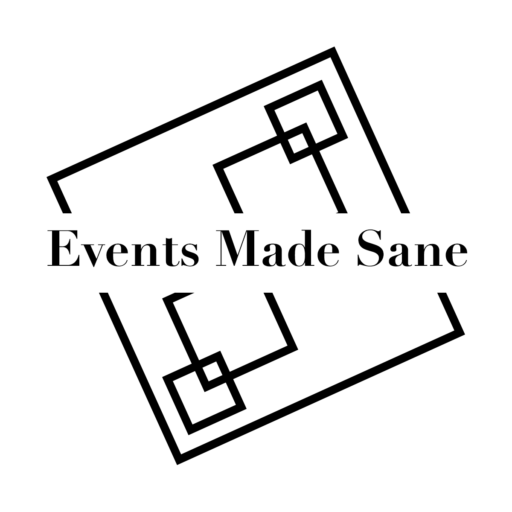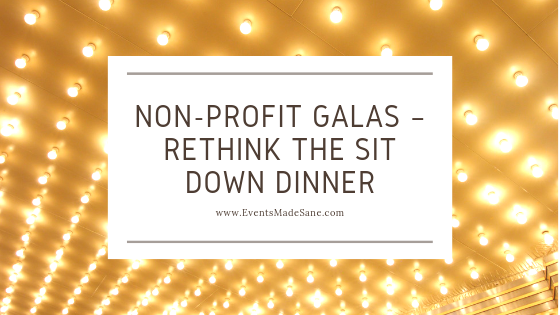
Events, Non-Profit
The non-profit galas have started to follow a very predictable formula. Attendees arrive for light appetizers and drinks, a sit-down meal is followed by a live auction and a 50/50 raffle, with a silent and dessert auction to round out the night. A DJ is often engaged but few people dance and rarely does the sound system give off the proper acoustics.
Want to surprise your guests and encourage them to spend more money? Want to get more sponsors and give them better visibility than a logo on the program?
Skip the sit–down dinner.
I know, this has made you money for a long time, why change up a good thing? Because attendees are getting bored and their pocket books are not opening as easily.
Here is what I would do instead.
Switch the sit-down dinner for heavy appetizer stations. You can theme the event and match the stations to the theme.
- A Southwest theme would have the following “stations”
- A make your own nacho bar
- A southwest egg roll station with a variety of dipping sauces
- Street Tacos with bean and rice
- A churro station with caramel and chocolate dipping sauce
- A spicy hot chocolate and spiked cider station for a winter event.
You can do this with any theme from around the world to baseball or even “Sport” food. Normal food can be renamed to fit the theme. One of the best examples is that a skewer of grapes can be called “Seaweed” for an under the water theme.
Why skip the sit–down meal?
Your guests are encouraged to move around the event more. You can sell sponsorships to each station and sell sponsorships to the sit down tables as well.
You can then add a VIP area. For the southwest theme – I would add a tequila garden where people can purchase 2 or 3 specialty drinks. Sponsors automatically get entrance to this area and some extra drink tickets. For an around the world theme, add a “passport” that people can purchase to have a glass of wine or beer with each station. I would allow people to purchase this at the event for twice the cost of the pre-event cost.
Then you put the silent auction tables near the stations and set up the stations so the line would form next to the silent auction items. People will spend more time looking at the items as they wait for food and you will most likely get higher bids.
How this approach makes things easier
- You will not need as many sit down tables and chairs because people will not need an assigned seat and save money.
- You do not need as many centerpieces for the above reason.
- You do not need to worry about meal options, people grab what they want.
- You surprise your guests with a new experience and something different from the normal steak and/ or chicken options that come with 90% of galas.
Things to watch for
- You will need more plates and utensils but can get smaller ones or use plastic
- If you can, get the plates that you can hang a wine glass on. This makes it much easier for guests to eat and buy more drinks.
- Ensure your caterer has a good staff that will keep stations well stocked.
- Lines will begin to form, use them to educate about your cause or make more money.
- You can do a VIP line like the express lane at Disney land for sponsors and those who pay for it.
If you are looking for something different and a way to surprise your guests, I think this is a great plan.
Reach out and I can help you brainstorm ideas for your next non-profit gala. I will offer a one hour consultation for free to any non-profit with a 501c(3) until June 30, 2019.
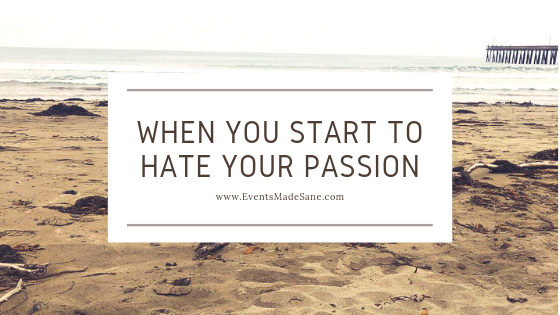
Events, Trade Show
I was putting together an event at work last week and a single thought rang through my head.
“I hate putting events together.”
Now, this is a scary thought for a person who has built her life and career towards putting together events. I did an event internship in college. I have gone through certification training for events. My blog is about events!
So, I took a day, ran to the beach to work out what had gone wrong and how to fix it. The beach is one of my calm places and has very few distractions. I put my feet in the sand and worked through this.
So what has gone “wrong”. I had 4 main points that I came up with.
1.My personal life has been intense lately.
For various reasons, I had to cancel my bachelorette party. (I am sitting about 100 yards away from the house that had been rented for that weekend as I write this.) My bridal party has had some shake ups, due to no fault of the people involved but life in general. Plus, working a full-time job, running a blog, and creating an online course about trade shows that will be released in the next two months. Oh, and wedding planning (with help). It has been a lot and your personal life spills over into your work life and vis-a–versa.
2. I have been focusing on the negatives of what people say about my events.
Before my above scary thought, I was running through the litany of complaints that I was sure would be aired because they had been aired at previous events. Complaints about location, decorations, food, the choice of drink, etc. Now, none of these complaints have been stated about one single event – but about events over two and a half years. But that was all I heard in my head.
3. I have done enough events that they have started to become routine.
With over a decade of events under my belt, I have learned a ton and I am able to put together simple events with ease. I now have an instinctive knowledge of what needs to be done and no longer get excited about the company happy hour or other events that I have done dozens of times. It is the same basic items, just the minute details change. I can plan, set up, and tear down on autopilot.
4. Events are hard work.
Events often require long days with very little breaks. Often, setting up the tables and chairs is the least strenuous part of the day. If you do not enjoy the events, it just makes the days longer.
Now, how am I going to turn this around? I refuse to give up. I love events too much to walk away from them but I obviously need to refocus.
My first step was to ask myself why I love events so much? What drew me to them, even after I knew the long hours and hard work needed?
I believe that my purpose in life is to make someone’s day.
Events have always been a great vehicle for me to do this. A great party can put a light in someone’s eyes as they let the worries and cares of a crazy world fall back and enjoy the moment. That feeling of enjoyment can carry on for weeks and the memory of a great event can last forever.
This holds true with business events as well. I want to provide content that will allow the attendees to grow their business or career. Helping people to reach for the next level – or just giving them the knowledge to protect their business is what I love to do.
With this answer the next step was to find my new areas to focus on.
I need to focus on the impact I am making on 80% of the attendees at any event.
I will never make everyone happy – even if I had a candy store I couldn’t make everyone happy.
I need to focus on the outcome of the event, not the set up and tear down.
I need to focus on the details and let the routine happen.
I am grateful for the years that I have spent planning and running events. I have wonderful memories from so many events – and all of those great memories correlate with the outcome.
So, when you look up one day and realize you hate doing your passion I would suggest doing the following
Ask yourself what has gone wrong?
Ask yourself why that was your passion? What was your driving force?
Can you refocus or is it time to find a new passion?
I wish you the best of luck on all of your journeys and hope you never come to the point I did but wanted to share my story to help those who do reach that fork in the road.

Events
Hosting an educational event can be a great way for your company to showcase its expertise and to gain new leads. Here are my top three things for hosting an educational event that will draw a crowd.
1. Pick a Timely and/ or Popular Topic
One my of the best-attended events was about the 2018 Tax Laws for Small Businesses. Pick a topic that will help your customers and your target audience.
If you are a makeup artist, offer to do live tutorials with people you will pick from the audience. If you are a real estate agent, bring in a mortgage person to discuss lending. If you are a boutique, do a fashion show where you pick audience members to wear your clothes and show people how to dress for their success
2. Pick the Right Speakers
I encourage you to bring in guest speakers for your events. Your customers hear from you in your social media, blogs, etc. Bring in a new perspective for them. Consider who your customers would benefit hearing from and invite them to speak. I love to create panels with two or three speakers. It gives my audience multiple perspectives and allows for debate. The other reason to bring in guest speakers is that they come with their own following that you can then use as leads.
3. Pick the Right Time
Take a hard look at your target audience for the event. Do surveys and see when most people will be able to attend. The timing of your event can mean everything.
Is your target moms? Do not schedule during pick up time at school.
Is your target small businesses? After 6 pm may be a good target, or a 5 am breakfast before business starts.
When possible plan an event at least 5 weeks out. One week for you and the speakers decide on times and topics and then 4 weeks to promote the event.
I love using educational events to get a businesses name and expertise out into the community. They are an inexpensive way to reach your target audience.
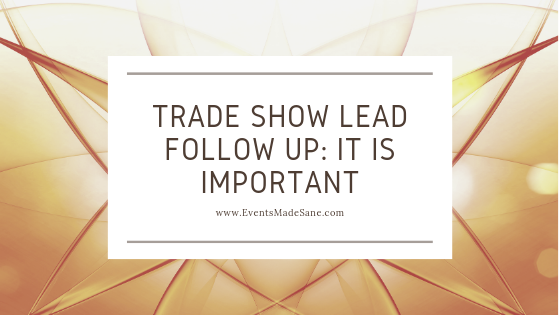
Uncategorized
You just had a great trade show. Traffic was awesome. Attendees were in your target market. Your giveaway bowl had to be emptied 3 times. Now, all you want to do is kick back with your favorite drink and watch the latest episodes of TV that you have been missing in preparation for the show.
But….
The show is not over, now is the post-show marketing and follow up. You get to take all of those leads, all of the business cards and the handwritten notes and decipher them to pull out every ounce of information possible to put into your CRM and email list.
Your leads are useless until you follow up on them.
Multiple studies have shown that the sooner you follow up after a trade show, the greater your response rate will be and leads gathered at a trade show have a greater response rate than other leads
Do not fall into the trap so many people do and just toss the leads or leave them to collect dust in a corner of your bottom drawer. Spend the night and day after a show entering as much information into a spreadsheet or your CRM.
I seperate my leads into 3 – 4 categories. I then have an email ready for each category and send that email out as soon as I have input the information. Then I move to the next category.
My categories follow these guidelines. You will find what works best for you.
- Solid prospects, people I spoke with and notated on their lead cards that I need to follow up.
- Prospects, these are people that gave me a name, phone number, and email address.
- Leads, these are the people that gave me a name and email address.
- Trick or Treaters, these are the people that scrawled a name and phone number just hoping to win what I was giving away.
Then use that information to send out an email. Have a picture of your booth (this reminds people who you are) and thank them for stopping by. I then pick one of the following:
- Offer a limited time discount on products or services
- Hold another giveaway for those people who follow you on social media
- Let people know what other events you will be at
Don’t let those leads go to waste. Follow up and expand your business.
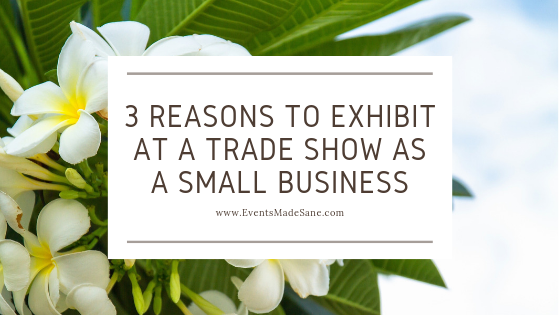
Trade Show
There are three reasons to exhibit at a trade show. Sell your product or service, gain leads for your business and to gain brand awareness. All other reasons fall under this. I want to walk through these reasons in detail and show how to make them work for you.
Sell
Selling at trade shows works if you fall in one of the below categories
- You have small items that people can impulse buy such as soaps, pillows, jewelry, clothes, etc.
- You are at a show where your specific products or services are needed such as wedding shows or home and garden shows
- You can give large discounts on big-ticket items or sell the “floor models”
elling at trade shows can be a hard prospect. Make sure the attendees match your target audience and that you have multiple ways to accept payment. Wifi or cellular does not always work.
Gain Leads
Leads are the main reason that service providers or large ticket item sellers go to a trade show. Leads can be gained in the form of business cards, badge scans, or written leads cards. One of the best ways to gather leads is to give something away in return. You can create a large basket to give away or have small items that people receive if they give you the proper information.
Brand Awareness
Getting your name out into the world is important for your business. Trade shows give you the opportunity to be in front of hundreds if not thousands of people in one day. Create an eye-catching booth and work on gathering leads and/or social media followers to extend your brand awareness past the show.
I would suggest picking two reasons to be at a show. Doing all three can become hectic in a 10 x 10 or 10 x 20 booth.
If you are going to sell your items, have a show special running. You can also gain brand awareness with a promotion where if they like your social media pages, they receive an extra amount off or a free product sample.
If you are going to gain leads, focus on your great giveaway (that still ties into your company’s voice and values). Do an added social media give away to encourage people to like and follow your pages.
A reason not to exhibit at a trade show is “Because my competitors are there.” Trade shows are too expensive for you to be there solely because someone else is. That will make for a miserable show. If you feel that you must attend, focus on one of the three reasons above and build your booth and show experience around that.

